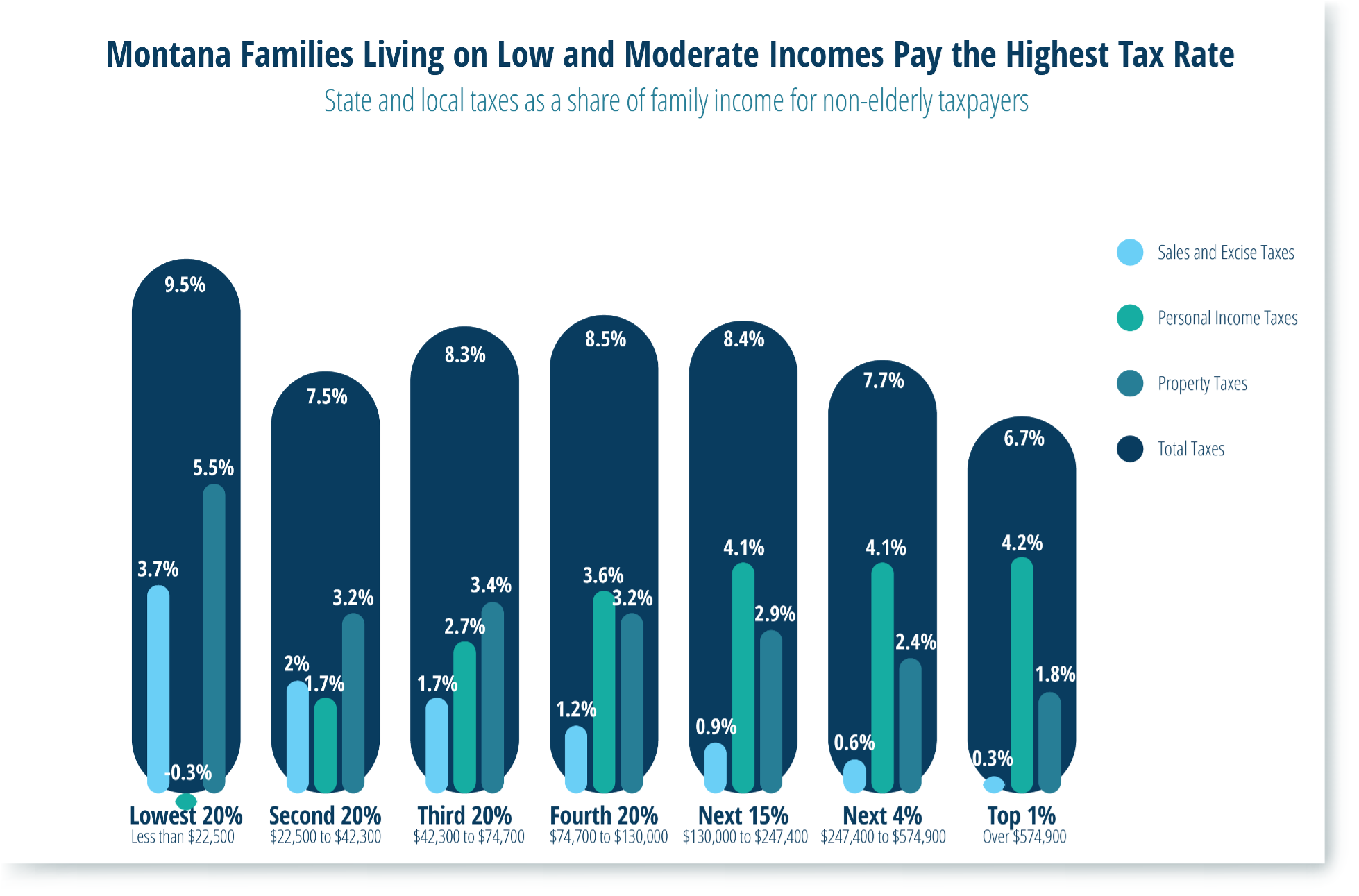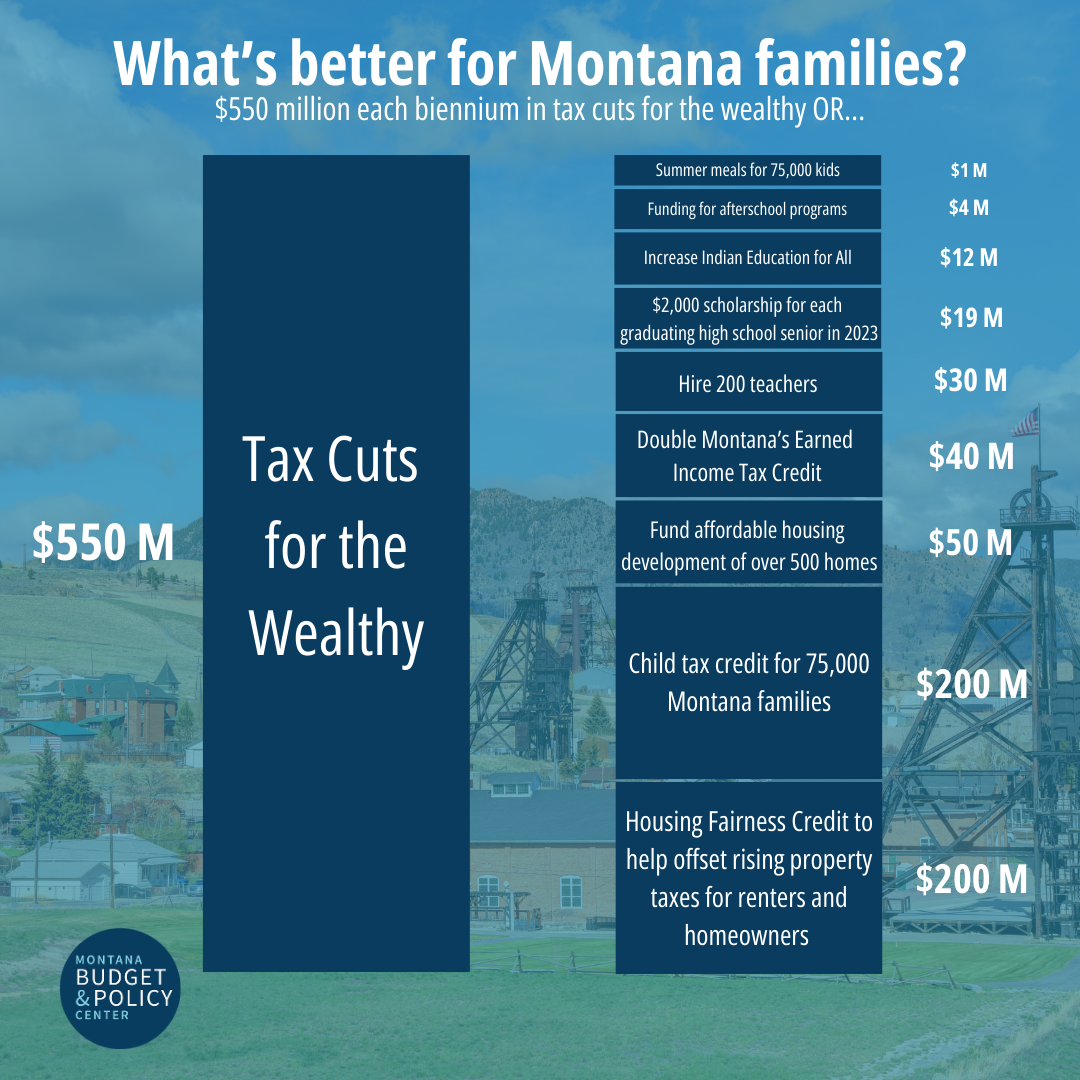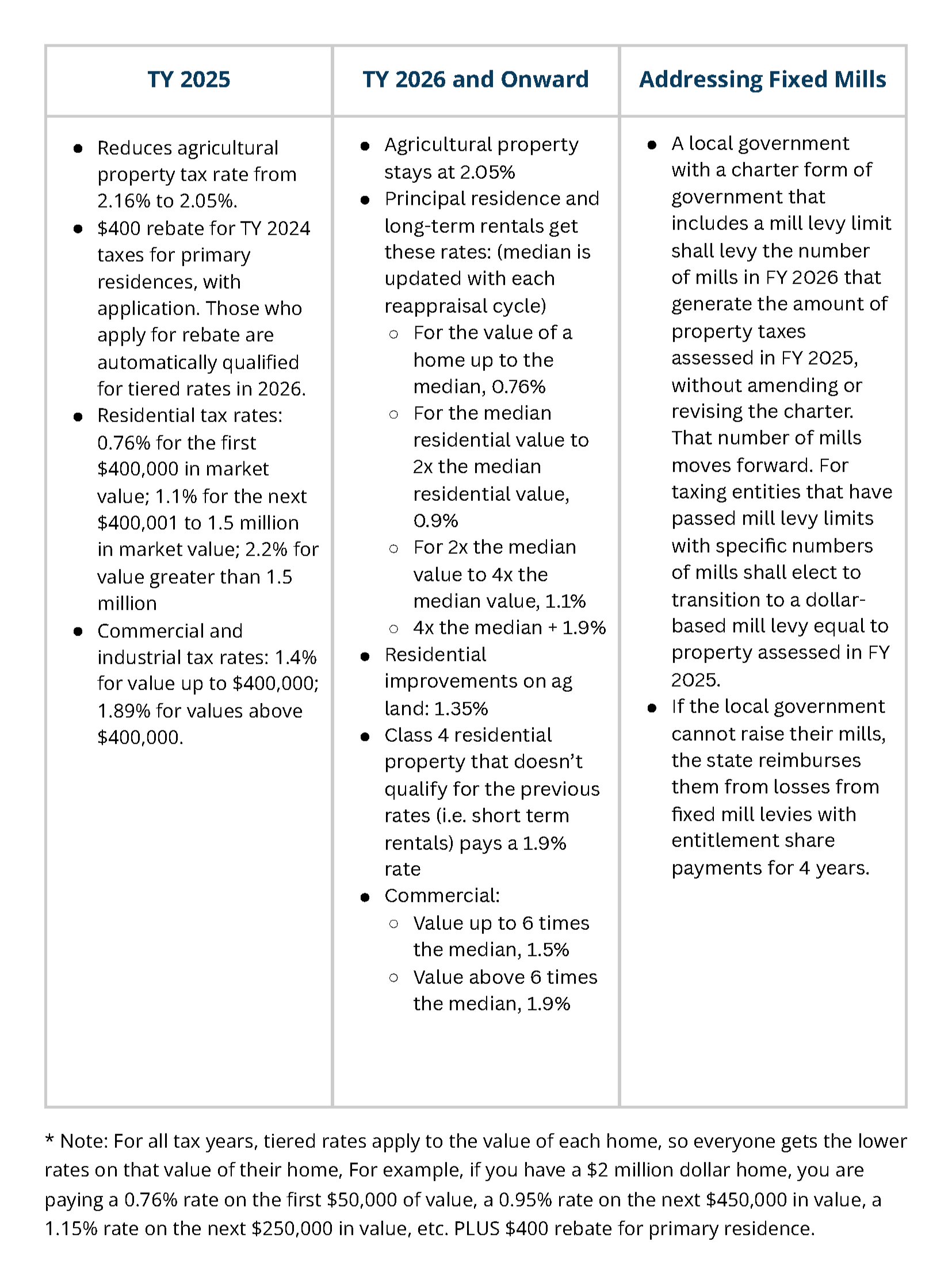The Montana budget serves as a collective tool to invest in keeping Montana a great place to live, work, and raise a family. The budget is funded in part by Montana’s tax system. The 2025 Legislature made a number of changes to the tax system, some of which come with a significant cost. When states cut revenue through things like reducing tax rates or passing tax exemptions, reduced revenue can result in budget cuts for things like roads and bridges, schools, and services for our seniors. Many state budgets are beginning to look bleak, even before the threat of federal budget cuts.[1] States that have cut taxes and lost revenue are failing to keep up with budgetary needs for schools, health care, and child care investments, and Montana often follows other states’ revenue trajectories.
Recent budget surpluses have been used in many states, including Montana, to justify large income tax cuts. But these surpluses reflect in part the historically large federal response to the COVID-19 pandemic, which bolstered state budgets through direct state aid and indirectly through economic relief to businesses and individuals, which then flowed into the tax system. The surpluses that many states, including Montana, have enjoyed are temporary, while the cost of cutting income taxes is permanent.
The 2025 Legislature made a number of changes to Montana’s tax system, including an expensive cut to the income tax and restructuring of the property tax system.
Income Tax Offsets Other Regressive Taxes
Montanans with the lowest incomes pay a higher percentage of their earnings toward all taxes than those with higher incomes.  While lower-income families pay a smaller share toward personal income taxes, they end up paying more overall due to the regressivity of property tax and various excise taxes for things like lodging, gas, and alcohol. The 2025 income tax cuts not only benefit wealthier households; they also make Montana’s entire tax system less fair.[2]
While lower-income families pay a smaller share toward personal income taxes, they end up paying more overall due to the regressivity of property tax and various excise taxes for things like lodging, gas, and alcohol. The 2025 income tax cuts not only benefit wealthier households; they also make Montana’s entire tax system less fair.[2]
Epic Fail: The Wealthy Benefit Most from Income Tax Cut
The Legislature passed HB 337, which will reduce the top income tax rate from 5.9 to 5.4 percent by 2027 and increased the state earned income tax credit (EITC) from 10 to 20 percent of the federal credit.[3] This bill disproportionately benefits the wealthiest Montanans, with two-thirds of the benefit going to the wealthiest 20 percent, at a cost of nearly $550 million each biennium once fully phased in.[4] While the top 1 percent receives over $6,000 on average in income tax cuts, those near the median receive a tax reduction of only $161 each year on average.
The EITC is a tax credit for working people with low and moderate incomes that helps boost low wages and offset the regressivity of the tax system. While increasing the EITC is a good way to improve the fairness of our overall tax system on its own, the total cost of increasing the EITC was less than 8 percent of the total cost of the bill.[5] Thus, as a whole, the income tax reforms were a tax giveaway to the wealthy, which put Montana at financial risk in the near future.

Biggest Surprise: Bipartisan Solution to Targeting Structural Property Tax Relief to Lower and Moderate Value Homes
After months of debate, the Legislature passed targeted, structural property tax reform that prioritizes relief to lower and moderate value primary residences and long-term rentals.
 The session began with residential property taxpayers reeling from two reappraisal cycles with strong residential growth compared to other types of property. Lawmakers on both sides of the aisle were set to cut property taxes for their residents, and the question remained of how to do so. During the interim, the governor convened a task force of stakeholders to develop a property tax relief proposal for the 2025 session.[6] In Montana, the property tax system at the local level is a zero-sum game. If one property value shrinks, the other parts must make up for the lost tax revenue, and vice versa. With residential values growing faster than other types of property, in addition to legislative decisions to lower rates and increase exemptions for other types of property, residential was paying a bigger share of the property tax pie than ever before.
The session began with residential property taxpayers reeling from two reappraisal cycles with strong residential growth compared to other types of property. Lawmakers on both sides of the aisle were set to cut property taxes for their residents, and the question remained of how to do so. During the interim, the governor convened a task force of stakeholders to develop a property tax relief proposal for the 2025 session.[6] In Montana, the property tax system at the local level is a zero-sum game. If one property value shrinks, the other parts must make up for the lost tax revenue, and vice versa. With residential values growing faster than other types of property, in addition to legislative decisions to lower rates and increase exemptions for other types of property, residential was paying a bigger share of the property tax pie than ever before.
The task force proposal gave primary residences and long-term rentals preferential tax rates compared to other types of residential property, like short-term rentals and second homes owned by both out-of-staters and Montana residentsIn the end, the residential tax rate of 1.35 percent was replaced with a tiered system based on the value of the home starting with a 0.76 percent tax rate. For tax year 2025, all residential properties, including second homes and short-term rentals, receive reduced tax rates for the portion of a home’s value up to $1.5 million. For the portion of a home’s value that exceeds $1.5 million, the tax rate increases to 2.2 percent. Primary residences also receive a $400 rebate in this first year.
For tax year 2026, residential property is split into two groups: primary residences and long-term rentals vs. second homes and short-term rentals. The first group, primary residences and long-term rentals, continue to receive the tiered rates with some changes to the tiers and the top rate capping at 1.9 percent. The second group, second homes and short-term rentals, pay that higher 1.9 percent rate for all home values. Second homes include many of the very high-value homes, often owned by out-of-staters, popping up in some parts of the state, and second homes owned by Montana residents that are not long-term rentals. The legislation included language directing local governments with fixed mills, like Billings, to levy the number of mills in 2025 that would generate the same revenue as they collected in 2024, and provided that the state would backfill revenue if that fix did not work. What does this mean for a Montana homeowner?
What does this mean for a Montana homeowner?
The impact of the legislation varies across the state, but in general, those with home values near the median see significant property tax reductions.[7] In tax year 2026, the top tax rate for the tiered rate system drops from 2.2 to 1.9 percent, while non-primary residences pay a 1.9 percent tax rate for the full value of the residence. As property taxation is quite complicated, the impact varies by home value and by community. Some examples are provided below, including primary residences with values somewhat near the median in Hill, Yellowstone, and Missoula Counties, and an example of a very high value non-primary residence in Madison County.[8] 
Left Out: 130,000 Renters Left Without Direct Assistance
Rising property taxes have been making housing costs unsustainable for Montana renters and homeowners of all ages. Montana’s tight rental market has left nearly half of all renters (46.6 percent) cost-burdened.[9] As renters pay property taxes through their rent, rising property taxes have made rent more unaffordable for many Montanans.
Tax credits targeted to Montana renters and homeowners who pay high effective property tax rates, like HB 154 proposed in 2025, are the most effective tool to promote property tax affordability.[10] Unfortunately, HB 154 did not make it to the finish line, leaving more than 130,000 Montana renters without direct property tax assistance.[11],[12]
Most Promising: Increasing Direct Renter/Homeowner Relief for Elderly
While direct relief for all ages of Montana renters did not make it to the finish line this session, an increase to the existing elderly homeowner renter credit made it to the Governor’s desk which provided some increased property tax assistance for older Montana homeowners and renters with high effective property tax rates. HB 831 increased eligibility for the elderly homeowner and renter credit and increased the credit amount by $250.[13] In 2023, over 15,000 older Montanans accessed the credit.[14] Increasing Montana’s elderly homeowner and renter credit will provide additional property tax relief for homeowners and renters 62 and over, helping to reduce the extreme regressivity of Montana’s property tax system.
Circuit breaker credits, like Montana’s elderly homeowner and renter credit, are the most effective tool available to promote property tax affordability for those eligible.[15] Montana can learn from this policy change and move toward providing similar policy for Montanans of all ages.
How to Make Our Tax System More Fair?
Over the last few decades, legislatures have cut income taxes, increased property tax exemptions, and lowered property tax rates for various types of business property. This, in addition to rising home values, has shifted tax responsibility onto the backs of everyday Montanans, families working for lower and more moderate incomes.
The 2025 Legislature interestingly made the income tax substantially less fair while improving the targeting of the property tax system. The 2025 income tax cut falls on the heels of successful attempts to lower the top income tax rate in 2021 and 2023, with the Governor’s ultimate stated goal of further lowering the top income tax rate and moving Montana to a flat income tax. Flat income taxes ensure that wealthy families’ total tax bill will be a lower share of their income than that paid by families with more moderate means.[16] A flat income tax would hurt the vast majority of Montana families by further shifting tax responsibility away from the wealthy and onto the backs of those working hard in our communities every day.
Montana policymakers have a responsibility to maintain a strong tax code that generates adequate revenue to fund public services, is fair and equitable, and that Montanans can count on. Future legislatures must maintain their hold on preserving the income tax system we have, work to restore some of the graduated brackets that have been lost in recent years, pass an all-ages property tax circuit breaker which provides relief to lower and moderate income homeowners and renters who pay high effective property tax rates, and consider passing a state child tax credit or further increasing the EITC to help working families afford rising costs.

MBPC is a nonprofit organization focused on providing credible and timely research and analysis on budget, tax, and economic issues that impact low- and moderate-income Montana families.